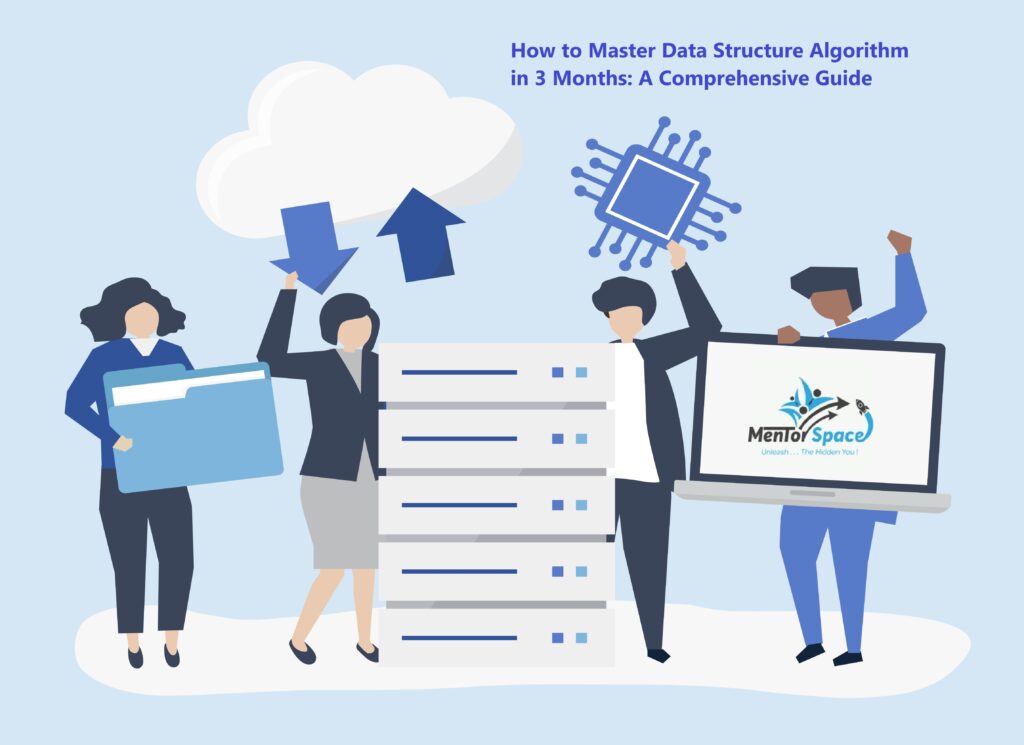1. Introduction: Master Data Structure Algorithm
Welcome to your journey towards Mastering Data Structure Algorithms in just three months. Whether you’re a programming enthusiast or preparing for technical interviews, this guide will help you build a strong foundation and problem-solving mind-set.
Table of Contents

2. Understanding Data Structures and Algorithms: (Master Data Structure Algorithm)
Before diving into coding, understand the importance of data structures and algorithms in software development. Data structures organize and store data efficiently, while algorithms provide step-by-step solutions to computational problems.
3. Creating a Learning Plan:
A- Set Clear Goals:
Define what you want to achieve in three months, such as mastering specific data structures, algorithms, or improving problem-solving skills.
B- Allocate Time:
Dedicate consistent daily hours to learning and practice.
C- Resources:
Gather relevant books, online courses, and coding platforms.
4. Mastering Basic Data Structures:
Begin with fundamental data structures: (Master Data Structure Algorithm)
A- Arrays:
Learn indexing, insertion, and deletion.
B- Linked Lists:
Understand singly and doubly linked lists.
C- Stacks and Queues:
Grasp LIFO and FIFO principles.
5. Exploring Advanced Data Structures:(Master Data Structure Algorithm)
Move to more complex structures:
A- Trees:
Learn binary trees, AVL trees, and heap trees.
B- Graphs:
Understand graph representations and traversal algorithms.
C- Hashing:
Study hash tables and collision resolution.
6. Understanding Algorithmic Complexity: (Master Data Structure Algorithm)
A- Time and Space Complexity:
Comprehend O(n), O(log n), and related concepts.
B- Big O Notation:
Understand its significance in evaluating algorithm efficiency.
7. Problem-Solving Strategies:
A- Algorithmic Thinking:
Break down problems into smaller steps.
B- Patterns:
Recognize common problem-solving patterns like sliding windows, dynamic programming, and greedy algorithms.
8. Regular Coding Practice:
A- Consistency:
Practice coding daily to reinforce learning.
B- Online Platforms:
Solve coding challenges on websites like LeetCode, HackerRank, and Codeforces.
9. Collaborative Learning and Resources:
A- Pair Programming:
Collaborate with others to solve problems.
B- Online Communities:
Join forums and communities to discuss doubts and solutions.
10. Tracking Progress and Making Adjustments:
A- Keep a Journal:
Note down your achievements and areas needing improvement.
B- Adapt the Plan:
Adjust your learning path based on progress and challenges faced.
More about Data structure: Wikipedia
Related our recent post:
Learn and Understand data structures and algorithm analysis

11. Conclusion:
Congratulations on your remarkable journey! You’ve grasped the essence of Data Structure Algorithms, gained problem-solving prowess, and elevated your programming skills. Remember, continuous learning is key to staying at the forefront of coding excellence.
By following this comprehensive guide, you’ll be well on your way to mastering Data Structure Algorithms in just three months. With dedication, consistent practice, and the right resources, you’ll enhance your programming capabilities and problem-solving skills. Start your journey today and embrace the rewarding world of algorithms and data structures!
FAQs:
Q: Why are data structures and algorithms important in programming?
A: Data structures organize and manage data, while algorithms provide step-by-step solutions to problems. They are fundamental for efficient software development and problem-solving.
Q: How can I create an effective learning plan for mastering data structures and algorithms in 3 months?
A: Set clear goals, allocate daily study time, gather relevant resources such as books and online courses, and track your progress to ensure you’re on the right path.
Q: What are some basic data structures I should start with as a beginner?
A: As a beginner, start with essential data structures like arrays, linked lists, stacks, and queues. These will lay the foundation for understanding more complex structures.
Q: What’s the significance of algorithmic complexity and Big O notation?
A: Algorithmic complexity, often expressed using Big O notation, helps analyze how algorithms perform in terms of time and space usage as the input size increases. It’s crucial for optimizing code efficiency.
Q: How can I enhance my problem-solving skills for data structure and algorithm challenges?
A: Develop algorithmic thinking by breaking down problems into smaller steps. Recognize common patterns like dynamic programming and greedy algorithms, and practice regularly on coding platforms.Q: What role does collaborative learning play in mastering data structures and algorithms?A: Collaborative learning, such as pair programming and participating in online communities,

